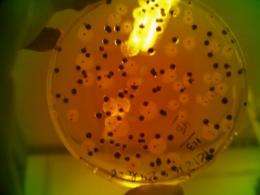Bacterial resistance to antibiotics: The more they resist, the more they divide

The number of multiresistant strains of bacteria in hospitals is increasing. Bacteria acquire resistance to antibiotics through mutations in their chromosomes and by incorporating new genes, either from the surrounding environment or from other bacteria. Now, a research team at the Portuguese CBA research (University of Lisbon) and the Instituto Gulbenkian de Ciência has shown that, surprisingly, when both mechanisms of resistance are playing out in the bacterium Escherichia coli (E. coli), its ability to survive and reproduce is increased. These results are now ublished in the open-access journal PLoS Genetics.
Usually, the acquisition of new genes, either through the insertion of pieces of DNA – called plasmids – or through mutations, comes at a cost to the bacteria, reflected in a reduction in its rate of cell division, for example. Francisco Dionísio, senior author of the paper, describes the process using the following analogy: "if you disassembled your computer and randomly changed connections and pieces, you wouldn't expect it to work better than before."
However, Francisco and his colleagues show that, when a mutation occurs in the chromosome of a bacterium that has already incorporated a resistance-carrying plasmid, the bacteria divide faster in 10% of the mutation-plasmid combinations tested. Similarly, bacteria that first acquire resistance to antibiotics through mutation of their chromosome and then gain further resistance by insertion of plasmids into their DNA show reproduction rate increases in 32% of combinations.
In 2009, the same research groups showed, for the first time, the importance of interactions between random genes in determining antibiotic resistance in bacteria. This latest study takes their initial findings a step further, by demonstrating that this is a general phenomenon, and thus may help to predict how a bacterial population will evolve after receiving a plasmid that confers resistance to a certain antibiotic.
Francisco Dionísio adds "These results are, at least, unexpected in light of what we previously knew about genetic interactions, and may underlie the mechanism whereby rapid resistance to antibiotics appeared.
Provided by Instituto Gulbenkian de Ciencia

















